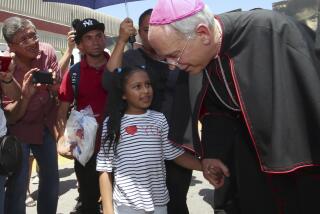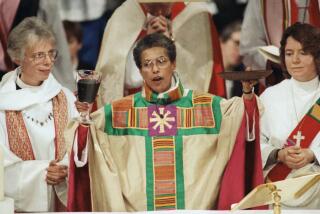COLUMN ONE : Striving to Serve God and Family : Married Roman Catholic priests still yearn to perform duties for their church. They seek an end to mandatory celibacy as the church faces a critical shortage of clergymen.
- Share via
SAN JOSE — They have acquired new loves along the way in wives and children. But an old love still burns in the hearts of many married Roman Catholic priests--the desire to serve their church as ordained ministers.
That is officially forbidden and only the Pope can change it. Many of the estimated 19,000 U.S. Catholic priests who have married in the past 20 years remain loyal, believing that they can function both as married men and effective ministers of the sacraments.
Meantime, their church is being hurt by a clergy shortage that grows steadily worse each year: 43% of the world’s parishes--and about one-tenth of the 19,500 U.S. parishes--do not have a regular priest. In the United States, according to studies, half of the priests under age 60 have married, and by the mid-1990s, the number of married priests is expected to equal or surpass the 26,000 unmarried active parish priests.
So, when several hundred married priests and their spouses held an annual meeting here recently, it was not surprising that they gently confronted the nation’s Catholic bishops--who by chance were attending their own retreat at nearby Santa Clara University. At a prayer vigil, and later with four bishops officially selected to meet with them, leaders of Corpus, the National Assn. for a Married Priesthood, pressed for the return of married priests to full sacramental service and an end to mandatory celibacy.
Although priestly celibacy is not on the agenda of a worldwide bishops conference in Rome next month, Brazilian and Canadian bishops have said that they will recommend that married men not previously ordained be eligible for priesthood.
Even officials at the U.S. Catholic Conference in Washington admit to an uncertainty about what to call the priests: resigned, inactive, or married.
Since the 4th Century, the Roman Catholic Church has decreed that its priests must be celibate, basing the requirement on the assumption that Jesus was unmarried, upon the words of Apostle Paul that “an unmarried man can devote himself (fully) to the Lord’s affairs” (1 Corinthians 7:32), and upon church tradition.
Some priests seek “laicization,” an often lengthy process whereby the Vatican releases a man from the priesthood and grants him full standing as a lay Catholic. Others skip the formalities.
Priests who marry find it is not always easy to deal with the guilt that lingers after having forsaken the vow of celibacy, or to change careers and take on family responsibilities at midlife.
Joseph Buko, a former Maryknoll missionary priest to Japan, said the toughest adjustments he faced when he resigned 22 years ago and married were retooling for another career and learning to be a family man.
“I went back to Fordham and got a degree in social work,” he said. “I had a theology degree but that won’t buy you any groceries. And getting used to kids again was difficult. I hadn’t seen a child for all those days I was in seminary, so I got a job as a trainee at a foster-care agency.”
Now, he and his wife, Ann, have four daughters. He works for the San Diego County Adoption Services. She is campus nurse at the University of San Diego and a consultant on sex education for the local diocese.
The Bukos are typical of couples who adjust well. Most married priests, who tend to be high achievers, are healthy, well-rounded persons, according to Terence Dosh, a former Benedictine monk who is national coordinator of Minneapolis-based Corpus. Most land on their feet financially.
“Ninety-nine percent of the men who left (in the late 1960s and early 1970s) were successful in making a good living--sometimes to the amazement and disappointment of those who stayed,” said Tom McMahon, a licensed family counselor who leads a weekly Eucharistic meeting in San Jose for a group of about 15 families. Younger priests, he added, typically have acquired degrees or skills that make it easier to find employment when they leave.
Don Kohles, who left the priesthood in 1978 after 20 years in a San Jose parish, found it “a bit traumatic” at first.
“I left with just a few bucks, had to house-sit and had no job for nine months,” he said. “My first job was driving a United Parcel Service truck. But friends helped me and I moved from pulpit to pew--I now administer a community service program for the same parish.”
Some married priests never quite make the transition.
“It’s still very painful,” confided one resigned priest who asked that his name not be used. “We’ll never get rid of the fact that we’re priests . . . I’m recovering from realizing they’ll never let me return to the priesthood just because I’m married.”
At least 5,000 married priests would like to serve their church in an ordained capacity, according to Dosh. About 30 to 40 of the nation’s 188 dioceses permit married priests to function in church jobs, he said, although they cannot administer the sacraments. Another 80 to 100 married priests teach theology at the university level--half of them at Catholic schools.
About 60% of those doing secular work are in social service professions; most of the rest are in a variety of businesses, according to a survey of 5,500 married priests made by Corpus.
For example, social worker James Mulligan counsels on legal, financial and family matters during the week in his job for the state of California and assists a Sacramento parish priest on Sundays. John Ilg of Portland runs his own rug- and upholstery-cleaning business. Nick De Los Reyes, who brought his wife and four young children to a recent conference of several hundred Corpus members, is a clinical psychologist in Seal Beach.
Priests who attended the conference at San Jose State University said celibacy was what drove most of them to resign.
“What happens,” said Buko, who led a workshop at the conference on how to cope with resigning from the priesthood, “is they meet a woman who is loving and sensitive, and they fall in love and that changes everything . . . Women teach us about intimacy--the opposite of clerical control and power.”
Recovering from such “clerical addictions” as “blind obedience, the clerical chain of command, anti-feminism, celibacy, and legalism” is a long, gradual process, Buko explained at the workshop.
Corpus, he added, “is enormous help as a mutual support system . . . It’s a kind of Priests Anonymous.”
With some exasperation, the married priests noted that since 1982 the Vatican has permitted dozens of married Episcopal priests and several Lutherans to convert to Roman Catholicism, remain married and celebrate Mass, hear confessions and perform other priestly duties.
“That’s a double standard,” said Guy Murning of Mill Valley, who was ordained a Catholic priest in 1970, but left to marry eight years ago.
In Zaire and Indonesia, according to Dosh, married priests are clandestinely serving because of specialized tribal needs and a priest shortage.
Speaking last month at the International Federation of Married Catholic Priests in the Netherlands, Anthony T. Padovano, president of Corpus, declared that “obligatory celibacy is the church’s Berlin Wall, its Eastern Europe under Soviet domination, its Stalinist and Brezhnev era before Gorbachev.”
On this issue, said Padovano, who presided at the San Jose meeting and spoke to a West Coast meeting of married priests in Buena Park last Saturday, Pope John Paul II “presents the image of an avenger, a Grand Inquisitor who holds married priests under house arrest until they recant by denying their marriages and their choices.”
Los Angeles Archbishop Roger M. Mahony does not think optional celibacy would help the church in the long run because Eastern rite Catholic churches, which permit married clergy, also have a priest shortage.
Optional celibacy “would be interesting and novel,” Mahony said, “but I think you’d see a transition . . . There would be a brief period when more men would become priests, but then it would level out to what Eastern rites have experienced.”
Married priests would not be available seven days a week, Mahony pointed out, and because of family commitments, they would be like others who live with family at home and work certain hours.
Opinions differ over whether a married priesthood would decrease the mounting reports of sexual misconduct by Catholic clergy.
“Certainly, priests are vulnerable from the inside because of their own sexual drives and from the outside because they become very attractive sexual targets,” said A. W. Richard Sipe, a former Benedictine monk who is married and practices psychotherapy in Baltimore. He will publish a 25-year study next month based on 1,000 interviews with priests and 500 of their intimates, concluding that half of all priests break celibacy vows.
Sipe’s findings come as surveys indicate a rising majority of U.S. priests and laity favor “optional celibacy” for priests who choose it.
While a number of married priests are seeking to refocus their sexuality, others are working their way through feelings that they let the church down when they were sorely needed.
Although Neal G. Hughes of Rye, Colo., has been married for 22 years, he still will not risk facing the disapproval and shame of his relatives in Ireland if he were to visit them “wearing a wedding ring and not in black with a collar.”
A lot of priests, said Paul Dion, who served under Bishop Leo T. Maher of San Diego before marrying in 1977, “have had to work through many layers of guilt . . . inculcated from their youth and the family values of being Roman Catholic.”
Part of it, he said, is feeling that, “I made a promise, a vow to God, and I haven’t been faithful to that vow, so now in my human weakness I have turned my back on him.”
Priests who resign may also feel bad about letting down their parishioners or the missionary society or seminary that trained them.
“I went through some of these things myself,” said Dion, “and still have to go through them.”
McMahon, who grew up in a staunch Irish Catholic family in San Francisco and served as a priest for 26 years, insists that he “never resigned.” He was ordered out of his parish in 1980, when the bishop learned that he had been quietly married for five years and had two children.
“I knew I would be cut off completely--pension, health benefits and work in the line I was trained in and accustomed to for over 38 years. I spent four years in therapy getting ready for the change and delighted I did,” he said.
More to Read
Sign up for Essential California
The most important California stories and recommendations in your inbox every morning.
You may occasionally receive promotional content from the Los Angeles Times.












